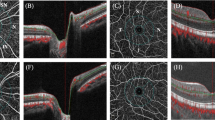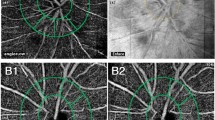Abstract
Purpose
Ocular hypertension (OHT) is a clinical entity characterized by elevated intraocular pressure (IOP) without optic nerve damage. In the presence of other risk factors, OHT may progress to glaucoma. This study aimed to evaluate ocular blood flow (OBF) and choroidal thickness (CT), which may be markers and/or risk factors that could assess the progression of OHT to glaucoma.
Material and methods
Age and gender matched 60 eyes of 32 patients with OHT and 61 eyes of 31 control patients were included for this study. All participants underwent a detailed ophthalmological examination including best-corrected visual acuity, IOP measurement with Goldmann applanation tonometry, gonioscopy, optic nerve evaluation with 78 D lens, and visual field test with Humphrey visual field analyzer. Retinal nerve fiber layer, ganglion cell complex, and central corneal thickness measurements were performed by optical coherence tomography (OCT). CT was measured with OCT in the fovea, 1.5 mm, 2 mm, 2.5 mm nasal and temporal to the fovea and from nasal and temporal to the optic disk. OBF data including peak systolic velocity (PSV), end-diastolic velocity (EDV), resistivity index (RI) and pulsatility index (PI) were measured with color Doppler imaging (CDI) from the ophthalmic artery (OA), central retinal artery (CRA), medial and lateral branches of short posterior ciliary arteries (MPCA, LPCA). Systolic (SBP) and diastolic arterial blood pressure were also noted.
Results
CT measurement at each point in the OHT group compared to the control group were found to be significantly thinner (p = 0.001). There was a decrement in CT from the fovea to the nasal and temporal retina in both groups. In the OHT group, there was a significant decrease in PSV and EDV of OA, CRA, MPCA, and LPCA, and a significant increase in PI and RI of measured arteries. (EDV p = 0.036, PI p = 0.006, RI p = 0.006 for OA and p = 0.001 for other arteries and all OBF measurements). There was a negative correlation between CT and age, IOP and axial length (AL) in OHT group (r = − 0.529, p = 0.001; r = − 0.258, p = 0.047; r = − 0.345, p = 0.007, respectively, for fovea). But there was no statistically significant correlation between CT and other measurements in the control group, except age (r = − 0.860 p = 0.001 for fovea).
Conclusion
We found that OBF decrement and choroidal thinning in OHT group compared with controls. Interpretation both of CT measurements with OCT and OBF parameters with CDI and new imaging technologies may help to prevent and reduce the possible optic nerve damage.





Similar content being viewed by others
Data availability
Can be made available if demanded.
References
Shields MB (ed) (2011) Textbook of glaucoma. Lippincott Williams and Wilkins, Baltimore
Shin JW, Sung KR, Song MK (2020) Ganglion cell-inner plexiform layer and retinal nerve fiber layer changes in glaucoma suspects. Am J Ophthalmol 210:26–34
Heijl A, Leske MC, Bengtsson B et al (2002) Reduction of intraocular pressure and glaucoma progression: results from the Early Manifest Glaucoma Trial. Arch Ophthalmol 120:1268–1279
Klein BE, Klein R, Sponsel WE et al (1992) Prevalence of glaucoma. The Beaver Dam Eye Study. Ophthalmology 99(10):1499–1504
Bonomi L, Marchini G, Marraffa M et al (1998) Prevalence of glaucoma and intraocular pressure distribution in a defined population: the Egna-Neumarkt study. Ophthalmology 105:209–215
Fuchsjager-Mayrl G, Wally B, Georgopoulos M et al (2004) Ocular blood flow and systemic blood pressure in patients with primary open-angle glaucoma and ocular hypertension. Invest Ophthalmol Vis Sci 45:834–839
Galassi F, Sodi A, Ucci F et al (2003) Ocular hemodynamics and glaucoma prognosis: a color Doppler imaging study. Arch Ophthalmol 121:1711–1715
Satilmis M, Orgul S, Doubler B et al (2003) Rate of progression of glaucoma correlates with retrobulbar circulation and intraocular pressure. Am J Ophthalmol 135:664–669
Pinto LA, Willekens K, Van Keer K et al (2016) Ocular blood flow in glaucoma—the Leuven Eye Study. Acta Ophthalmol 94:592–598
Marangoni D, Falsini B, Colotto A et al (2012) Subfoveal choroidal blood flow and central retinal function in early glaucoma. Acta Ophthalmol 90:288–294
Pemp B, Georgopoulos M, Vass C et al (2009) Diurnal fluctuation of ocular blood flow parameters in patients with primary open-angle glaucoma and healthy subjects. Br J Ophthalmol 93:486–491
Tasman W (ed) (2013) Duane’s ophthalmology. Lippincott Williams and Wilkins, Philadelphia
Tobe LA, Harris A, Hussain RM et al (2015) The role of retrobulbar and retinal circulation on optic nerve head and retinal nerve fibre layer structure in patients with open-angle glaucoma over an 18-month period. Br J Ophthalmol 99(5):609–612
Butt Z, O’Brien C, McKillop G et al (1997) Color Doppler imaging in untreated high- and normal-pressure open-angle glaucoma. Invest Ophthalmol Vis Sci 38(3):690–696
Findl O, Rainer G, Dallinger S et al (2000) Assessment of optic disk blood flow in patients with open-angle glaucoma. Am J Ophthalmol 130(5):589–596
Fan N, Wang P, Tang L (2015) Ocular blood flow and normal tension glaucoma. BioMed Res Int 2015:308505
Galassi F, Giambene B, Varriale R (2011) Systemic vascular dysregulation and retrobulbar hemodynamics in normal-tension glaucoma. Invest Ophthalmol Vis Sci 52:4467–4471
Drance S, Anderson DR, Schulzer M (2001) Risk factors for progression of visual field abnormalities in normal-tension glaucoma. Am J Ophthalmol 131(6):699–708
Nicolela MT, Drance SM, Rankin SJ et al (1996) Color Doppler imaging in patients with asymmetric glaucoma and unilateral visual field loss. Am J Ophthalmol 121(5):502–510
Zeitz O, Galambos P, Wagenfeld L et al (2006) Glaucoma progression is associated with decreased blood flow velocities in the short posterior ciliary artery. Br J Ophthalmol 90(10):1245–1248
Xu S, Huang S, Lin Z et al (2015) Color Doppler imaging analysis of ocular blood flow velocities in normal tension glaucoma patients: a meta-analysis. J Ophthalmol 2015:919610
Akarsu C, Bilgili MY (2004) Color Doppler imaging in ocular hypertension and open-angle glaucoma. Graefes Arch Clin Exp Ophthalmol 242(2):125–129
Nakazawa T (2016) Ocular blood flow and ınfluencing factors for glaucoma. Asia Pac J Ophthalmol (Phila) 5(1):38–44
Orgul S, Cioffi GA, Wilson DJ et al (1996) An endothelin-1 induced model of optic nerve ischemia in the rabbit. Invest Ophthalmol Vis Sci 37(9):1860–1869
Kawasaki R, Wang JJ, Rochtchina E et al (2013) Retinal vessel caliber is associated with the 10-year incidence of glaucoma: the Blue Mountains Eye Study. Ophthalmology 120:84–90
Meng N, Zhang P, Huang H et al (2013) Color Doppler imaging analysis of retrobulbar blood flow velocities in primary open-angle glaucomatous eyes: a meta-analysis. PLoS ONE 8(5):e62723
Stalmans I, Siesky B, Zeyen T et al (2009) Reproducibility of Color Doppler imaging. Graefes Arch Clin Exp Ophthalmol 247(11):1531–1538
Mayama C, Araie M (2013) Effects of antiglaucoma drugs on blood flow of optic nerve heads and related structures. Jpn J Ophthalmol 57:133–149
Harris A, Jonescu-Cuypers CP (2001) The impact of glaucoma medication on parameters of ocular perfusion. Curr Opin Ophthalmol 12(2):131–137
Okutucu M, Fındık H, Arslan MG (2019) Direct and crossover effects of brinzolamide, betaxolol, and latanoprost on choroidal thickness. Cutan Ocul Toxicol 38(2):196–200
Wu SY, Nemesure B, Hennis A et al. Barbados Eye Studies Group (2006) Nine-year changes in intraocular pressure: the Barbados eye studies. Arch Ophthalmol 124(11):1631–1636
Bonomi L, Marchini G, Marraffa M et al (2000) Vascular risk factors for primary open angle glaucoma: the Egna-Neumarkt Study. Ophthalmology 107(7):1287–1293
Mitchell P, Lee AJ, Rochtchina E et al (2004) Open-angle glaucoma and systemic hypertension: the Blue Mountains Eye Study. J Glaucoma Aug;13(4):319–326.
Chung HJ, Hwang HB, Lee NY (2015) The association between primary open-angle glaucoma and blood pressure: two aspects of hypertension and hypotension. Biomed Res Int 2015:827516
Leske MC, Wu SY, Hennis A et al (2008) Risk factors for incident open-angle glaucoma: the Barbados Eye Studies. Ophthalmology 115(1):85–93
Leske MC (2009) Ocular perfusion pressure and glaucoma: clinical trial and epidemiologic findings. Curr Opin Ophthalmol 20(2):73–78
Margolis R, Spaide RF (2009) A pilot study of enhanced depth imaging optical coherence tomography of the choroid in normal eyes. Am J Ophthalmol 147(5):811–815
Ikuno Y, Kawaguchi K, Nouchi T et al (2010) Choroidal thickness in healthy Japanese subjects. Invest Ophthalmol Vis Sci 51(4):2173–2176
Spaide RF, Koizumi H, Pozzoni MC (2008) Enhanced depth imaging spectral-domain optical coherence tomography. Am J Ophthalmol 146(4):496–500
Zhang Z, Yu M, Wang F et al (2016) Choroidal thickness and open-angle glaucoma: a meta-analysis and systematic review. J Glaucoma 25:446–454
Pablo LE, Bambo MP, Cameo B et al (2018) The use of zonal analysis of peripapillary choroidal thickness in primary open-angle glaucoma. Jpn J Ophthalmol 62(1):41–47
Lin Z, Huang S, Huang P et al (2018) Analysis of choroidal thickness in ocular hypertensive patients using enhanced depth imaging optical coherence tomography. Lasers Med Sci 33(1):111–121
Funding
All authors certify that they have no affiliations with or involvement in any organization or entity with any financial interest or non-financial interest in the subject matter or materials discussed in this manuscript.
Author information
Authors and Affiliations
Contributions
All authors have contributed to the design of the study, the interpretation of data, the draft, gave their final approval to the manuscript, and agree to be accountable for all aspects of the work.
Corresponding author
Ethics declarations
Conflict of interest
The authors declared no potential conflict of interest.
Ethics approval
All procedures performed in this study involving human participants were in accordance with the ethical standards of the institutional and/or national research committee and with the 1964 Helsinki declaration and its later amendments or comparable ethical standards.
Consent to participate
A written consent was obtained from each subject.
Consent for publication
Not applicable. This manuscript does not contain personal and/or medical information about an identifiable living individual.
Additional information
Publisher's Note
Springer Nature remains neutral with regard to jurisdictional claims in published maps and institutional affiliations.
Rights and permissions
About this article
Cite this article
Bayraktar, S., İpek, A., Takmaz, T. et al. Ocular blood flow and choroidal thickness in ocular hypertension. Int Ophthalmol 42, 1357–1368 (2022). https://doi.org/10.1007/s10792-021-02123-2
Received:
Accepted:
Published:
Issue Date:
DOI: https://doi.org/10.1007/s10792-021-02123-2




